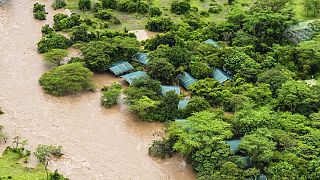Kenya
Two mountain bongos are released into the forest on the slopes of Mount Kenya.
Two might not look like much but the total wild population of these antelope is less than 100.
The program is being run by the Mount Kenya Wildlife Conservancy which breeds these beautiful creatures in captivity and then releases them into their natural habitat.
They've reintroduced a total of 10 bongos in recent days.
"So we have reintroduced them again within the Mt. Kenya forest which we know is a former bongo range," says Dr Robert Aruho, head of the mountain bongo program.
"The bongos used to live there and now today we witnessed another occasion where these animals again have been sent back to their wild home in their former range," he adds.
Mountain bongos were once common in Kenya, especially in the Mt. Kenya forest but there are now so few that they're classified as "critically endangered" by the IUCN (International Union for Conservation of Nature).
"So, poaching for bushmeat, then live trade for those who wanted to keep mountain bongos and then also hunting because of their trophies, skin and the horns. That brought the numbers of bongos to go so low," says Aruho.
"As the Bongo was still struggling, there was a rinderpest (cattle plague) outbreak in 1980 here in Kenya which killed most of the ungulates and the bongo also was not spared. And that crashed the population to less than 100 individuals and its recovery has been so slow in the wild and that's why now the only possible route for recovery was to breed the mountain bongo and then re-wild them," he adds.
According to Aruho, the mountain bongo's survival in its natural environment is crucial for balance in the ecosystem.
He believes that the presence of this "flagship species" will ultimately protect their forest habitat.
At Mt Kenya Wildlife Conservancy the bongos are 'trained' to survive in the wild.
At the beginning they are provided with up to 75% of their diet which then tapers off to 50% and then 30%, as they learn to look for food on their own.
Once they are released into the wild, they should be able to fend for themselves and even fight off predators.
The conservancy plans to release 50 mountain bongos by 2025.
The Mawingu Mountain Bongo Sanctuary is fenced but there are plans to remove the fence once a certain number of animals is reached.












00:45
First outing for rare Giraffe calf at UK's Chester Zoo leaves great impression
02:29
Africa's birds of prey under threat of extinction
02:30
Kenya: After a successful relocation, 21 black rhinos start journey to a new home
01:53
Madagascar celebrated at London orchid festival
02:45
A rhinoceros is pregnant from embryo transfer in a success that may help nearly extinct subspecies
01:35
21 black rhinos relocated to Kenya's Loisaba Conservancy